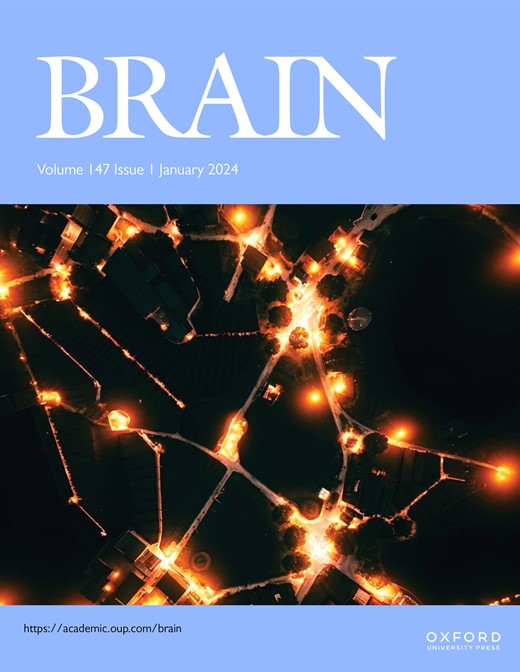GRIN2D发育性和癫痫性脑病小鼠模型再现了人类疾病
IF 10.6
1区 医学
Q1 CLINICAL NEUROLOGY
引用次数: 0
摘要
编码NMDA受体(NMDAR)亚基之一的GRIN2D致病性变异与发育性和癫痫性脑病(dei)有关。不同于新生突变,在多例患者中发现了复发性,新生,功能获得,错义突变c.1999G>A (p.Val667Ile)。我们利用行为范式、急性脑切片电生理记录(主要关注小脑浦肯野神经元(PNs)的活动)以及监测大脑活动和对几种药物反应的皮质电图(ECoG)记录,对携带同源Grin2d突变的小鼠模型进行了表征。Grin2d突变小鼠表现出一系列与人类疾病密切相关的表型,包括过早死亡、自发性癫痫发作和早期运动缺陷,随后是认知障碍。此外,我们观察到PNs的复杂发育变化,在未成熟小鼠中自发放电减少,在老年小鼠中对NMDA应用的突触反应增强。ECoG记录显示了深度和持续的异常大脑活动,具有改变的光谱特性和显著的θ、α和β波段窄带活动,与具有相同GRIN2D致病变异的患者的模式相似。低剂量(0.5 mg/kg)的氯胺酮急性给药对光谱性质的影响有限,高剂量(4或10 mg/kg)引起癫痫发作。相反,美金刚(10mg /kg)和苯妥英(30mg /kg)对ECoG性能的矫正作用较小。总之,Grin2d突变小鼠概括了致病性Grin2d变异患者的关键表型,包括独特的异常脑振荡,这可能作为定量药物反应和指导未来研究工作的生物标志物。本文章由计算机程序翻译,如有差异,请以英文原文为准。
A mouse model of GRIN2D developmental and epileptic encephalopathy recapitulates the human disease
Pathogenic variants in GRIN2D, encoding one of the subunits of the NMDA receptor (NMDAR), are associated with developmental and epileptic encephalopathies (DEEs). Unusual for de novo mutations, the recurrent, de-novo, gain of function, missense mutation c.1999G>A (p.Val667Ile) was discovered in multiple patients. We characterized a mouse model carrying the orthologous Grin2d mutation, using behavioral paradigms, electrophysiological recordings in acute brain slices focusing mainly on the activity of Purkinje neurons (PNs) in the cerebellum, and electrocorticography (ECoG) recordings monitoring brain activity and the response to several drugs. Grin2d mutant mice exhibit a range of phenotypes that closely mirror the human disease, including premature mortality, spontaneous seizures, and early onset of motor deficits followed by cognitive impairment. In addition, we observed complex developmental changes in PNs with reduced spontaneous firing in immature mice and augmented synaptic response to NMDA application in older mice. ECoG recordings demonstrated profound and continuous abnormal brain activity, with altered spectral properties and a prominent narrowband activity in the theta, alpha, and beta bands, paralleling the patterns seen in a patient with the same GRIN2D pathogenic variant. Acute administration of ketamine at a low dose (0.5 mg/kg) had a limited effect on the spectral properties, and higher dosages (4 or 10 mg/kg) caused seizures. Conversely, memantine (10 mg/kg) and phenytoin (30 mg/kg) demonstrated a small corrective effect on ECoG properties. Together, Grin2d mutant mice recapitulate key phenotypes of patients with pathogenic GRIN2D variants, including unique, abnormal brain oscillations, which may serve as a biomarker for quantifying drug responses and guiding future research efforts.
求助全文
通过发布文献求助,成功后即可免费获取论文全文。
去求助
来源期刊

Brain
医学-临床神经学
CiteScore
20.30
自引率
4.10%
发文量
458
审稿时长
3-6 weeks
期刊介绍:
Brain, a journal focused on clinical neurology and translational neuroscience, has been publishing landmark papers since 1878. The journal aims to expand its scope by including studies that shed light on disease mechanisms and conducting innovative clinical trials for brain disorders. With a wide range of topics covered, the Editorial Board represents the international readership and diverse coverage of the journal. Accepted articles are promptly posted online, typically within a few weeks of acceptance. As of 2022, Brain holds an impressive impact factor of 14.5, according to the Journal Citation Reports.
 求助内容:
求助内容: 应助结果提醒方式:
应助结果提醒方式:


